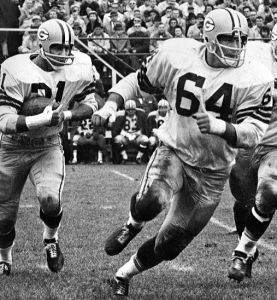Terrell Who? Today is Jerry Kramer’s Day
When we started Sports Then and Now nine years ago, one of the first things we did was create a list of former NFL players who we felt were deserving of being included in the Pro Football Hall of Fame, but up until that time had been snubbed for induction.
Number one on that list was former Green Bay Packers offensive lineman Jerry Kramer. Today, Kramer’s name can finally be removed from that list.
While one member of the Hall of Fame class of 2018 is trying to steal the attention by focusing on what he believes was a personal snub not to be a first-year inductee, in reality, his perceived snub and hardship is nothing compared to what Jerry Kramer has endured over the last half century.
When the NFL announced the 50th Anniversary All-NFL Team in 1969, Jerry Kramer was one of the two offensive guards named to the team. Yet, it took until just one year before the 100th Anniversary All-NFL Team will be announced before Kramer was selected for the Pro Football Hall of Fame.
The Green Bay Packers of the 1960s were one of the great dynasty teams in NFL history. Kramer will join 12 other members of the 1960s Packers (plus Coach Vince Lombardi) in the Hall of Fame.
Kramer retired after the 1968 season and was first listed as a Hall of Fame finalist in 1974. Initially, it seemed likely that Kramer would be inducted pretty quickly. He was a finalist seven times in an eight year stretch between 1974 and 1981 while seven of his teammates were inducted.
At that time, Kramer wasn’t the only 1960s Packer having to wait his turn for induction. In 1981, two of his former teammates, Willie Davis and Jim Ringo, were inducted in their sixth and seventh years as a finalist, respectively. Later in the decade, Paul Hornung was selected in his 12th year as a finalist in 1986 and Willie Wood in 1989 in his 10th time as a finalist.
Kramer was again a finalist in 1984 and 1987, but still had not yet received the call.
It was at that point where it started to become clear that the five-time first team All-Pro’s path to the Hall of Fame was not going to be as smooth as originally anticipated.
In 1995, former Green Bay defensive tackle Henry Jordan was selected for the HOF the fourth time he was a finalist. Two years later, Kramer was a finalist for the 10th time, but was not selected.
No one knew at the time, but that would be the start of a two decade period in which many offensive linemen without the career pedigree of Kramer would be inducted into the HOF, but Kramer would get no consideration.
Some thought the reason Kramer was no longer being considered for the HOF was a fatigue for the 1960s Packers, especially since by that point more than 10 players from that era had been inducted and the younger HOF voters were not old enough to remember the dominance of the Packers.
That myth was debunked in 2013 when former Green Bay linebacker Dave Robinson, who was an All-Pro only once in his career and had never previously been a Hall of Fame finalist was inducted as a senior nominee.
Anyone who thought the snub of Kramer wasn’t personal had a very time defending that argument after Robinson was inducted.
While it is still difficult to really understand why Kramer was snubbed by the HOF voters for more than four decades, there are some potential explanations.
Likely the most reasonable is that while the Packers were a team of stars, Kramer was the one player during and after their championship decade who seemed more than willing to be the media face of the group.
In 1968, he and Dick Schaap co-wrote a best-selling book called Instant Replay that chronicled the final championship season of the Packers’ dynasty. In addition, you can’t seem to find many NFL Films from the 1960s that don’t include an interview with Kramer talking about Lombardi and the great Green Bay teams.
Then, two decades later, Kramer marked the 20th anniversary of the 1967 team with another book titled Distant Replay.
Given that members of the Hall of Fame voting committee have snubbed former players for less, it is plausible that jealousy that a “dumb lineman” had written two best-selling books played a role in why Kramer was snubbed.
Over the last 10-15 years, Kramer has become kind of a cult-hero for older NFL fans who saw his continued omission from the Hall of Fame as an affront to their football memories. Kramer has been at the top of almost every list of former players deserving of induction.
When he was finally announced as one of the 2018 senior nominees last summer, you could just feel vintage football fans holding their collective breadth until the selection announcement in February. There was certainly hope that this would be the time, but also knowledge that if for some reason Kramer was not selected, it would likely be the last chance during his lifetime.
Fortunately, the current Hall of Fame selectors corrected an error made by multiple generations of voters and Kramer is finally getting his just recognition.
To his credit, though Kramer would certainly have every right to join another incoming Hall of Famer in boycotting the ceremonies, he has done basically the opposite. He has not dwelled on the more than four decades of snubs, but is making sure to enjoy his induction year.
He certainly deserves his moment in the spotlight and I look forward to watching him soak it in. Congratulations Jerry!
